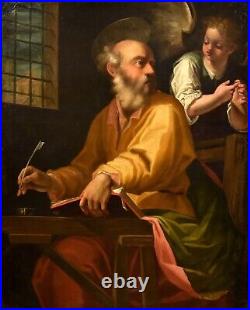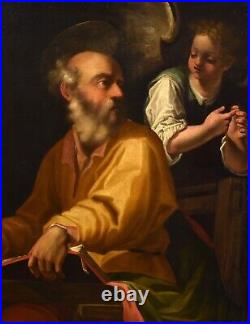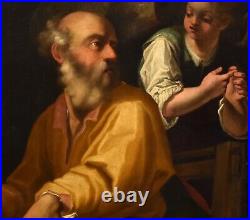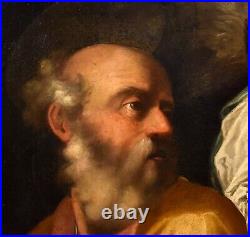Large Painting Antique Saint Matthew Angel Procaccini Xvii Century Oil on Canvas
















Large Painting Antique Saint Matthew Angel Procaccini Xvii Century Oil on Canvas. The description of this item has been automatically translated. Painter active in Lombardy, in Milan, in the seventeenth century. Circle of Camillo Procaccini (Bologna 1561 - 1629 Milan). 120 x 96 - In frame 135 x 112 cm.
Full details of this painting direct to the following - links. The canvas that we are illustrating, characterized by a remarkable expressive capacity, shows the portrait of the Evangelist Matthew, engaged in writing his Gospel, while he receives the indications of the angel who appeared behind him, which will become his iconographic attribute. The intense play of their gazes leads back to the symbolic meaning, enclosed in the Catholic tradition, of collaboration between God and man, and refers to a sort of theatrical representation where the actions of the two protagonists blend perfectly. Matthew is sitting at his desk, he has just stopped writing to dip the quill in the inkwell and turn around at the same time and observe the divine messenger, as if he needed help. His gaze is attentive, devoted, respectful, waiting to grasp the sacred word, and directed towards the eloquent gesture of the angel who counts the genealogy of Christ with his hands.
In fact, the messenger does not guide Saint Matthew's hands directly but counts with his fingers, retracing the generations that connect Christ to King David (precisely the 42 generations of Jesus' ancestors). What stands out in the painting are the vivid and warm colors, which give a great softness, and the powerful light that radiates the scene, which seems directed to the angel's gesture, as if to emphasize its role of guide. The work is perfectly ascribed to the Lombard pictorial current of the seventeenth century, an extraordinarily happy artistic period which, especially in the first half of the century, saw the succession of an impressive array of leading artistic personalities. Even if it deserves a specific study, which identifies its authorship in a more restricted way, our canvas, with its direct and engaging devotional intensity, recalls in particular the works of Camillo Procaccini (Bologna 1561 - Milan 1629 Milan), and can be assigned to an author of his circle.
Son of art and belonging to a large family of painters, he began his training right in the workshop of his father Ercole Procaccini the Elder, and then moved to Milan in 1587. Here he will work for most of his career, becoming one of the protagonists of the local art scene between the end of the 16th and 17th centuries.
Still inspired by the models of Emilian Mannerism, our painting connects to more mature works, in which his formally clear style (reminiscent of the example of the Carraccis) however moves away from the dramatic sense, marked by chiaroscuro excesses, which characterized the language more properly Lombard of Morazzone, Cerano and Giulio Cesare Procaccini. Beautiful gilded wooden frame, not coeval. It is also possible to see the painting in the Riva del Garda gallery, we will be happy to welcome you to show you our collection of works. Still inspired by the models of Emilian Mannerism, our painting connects to more mat. Cerchia di Camillo Procaccini (Bologna 1561 - 1629 Milano).